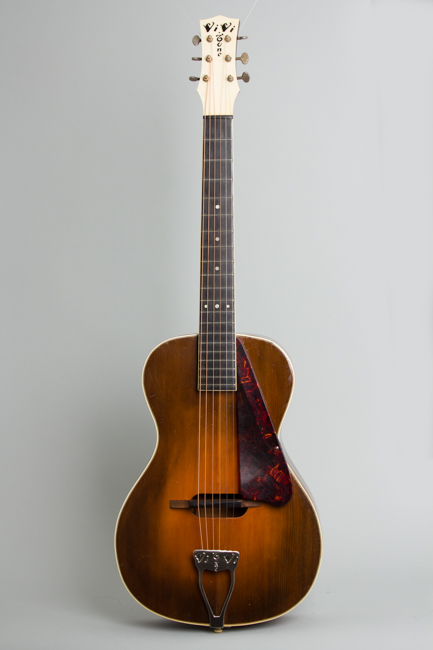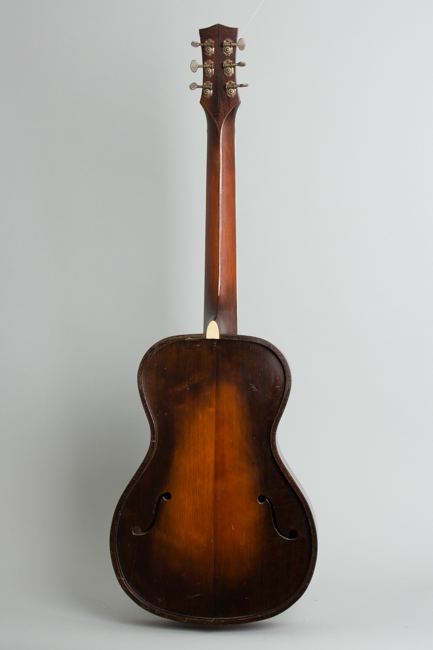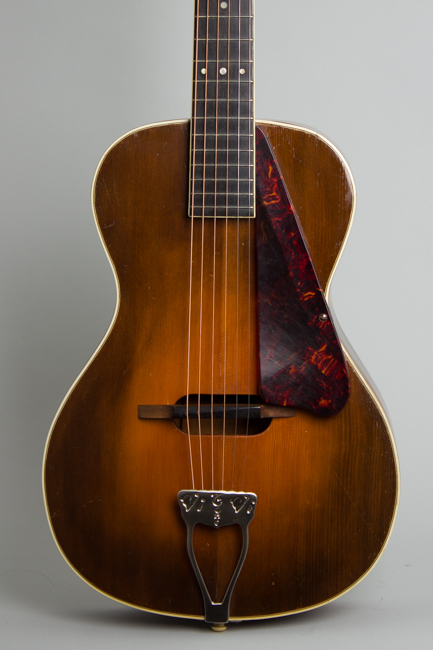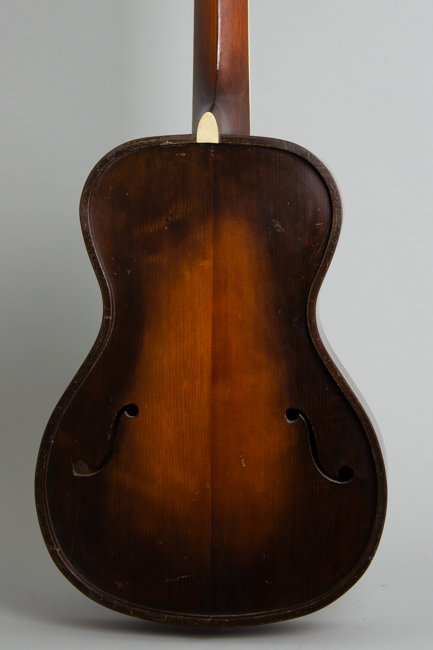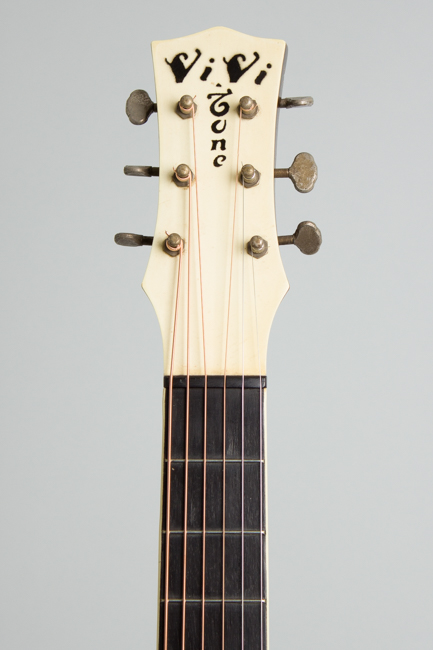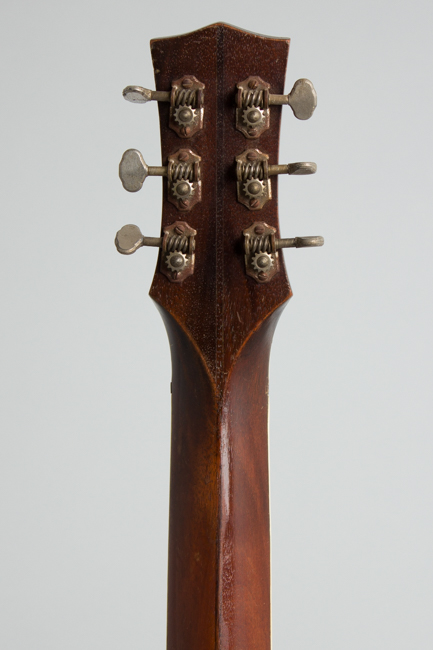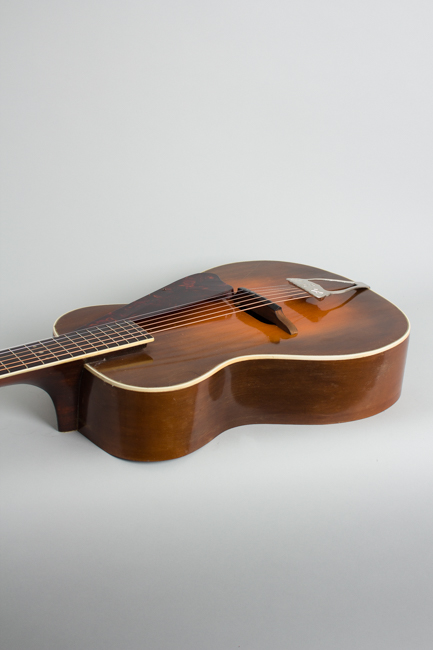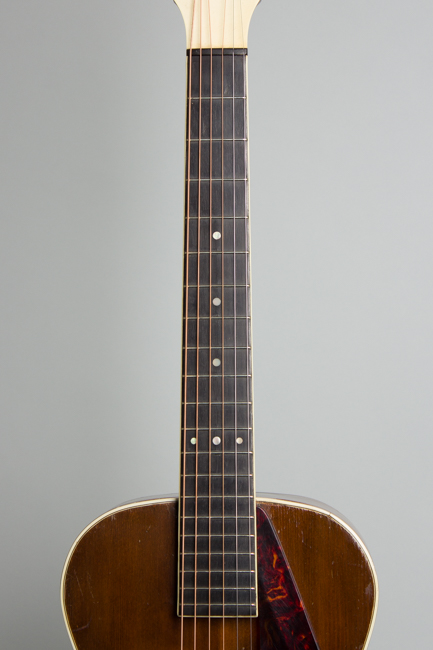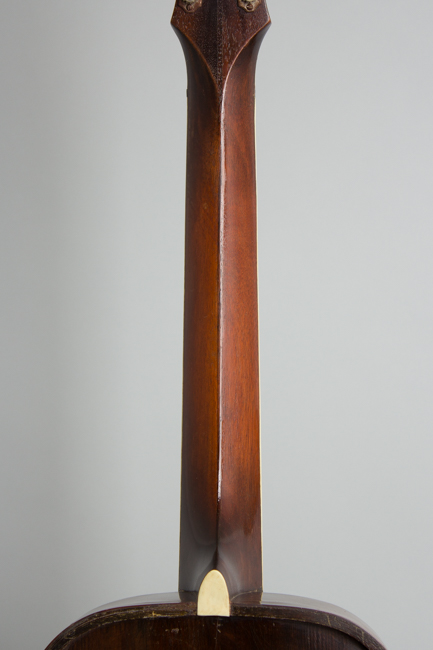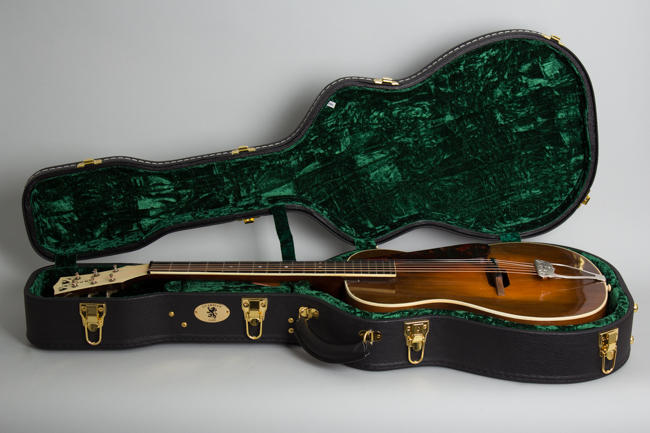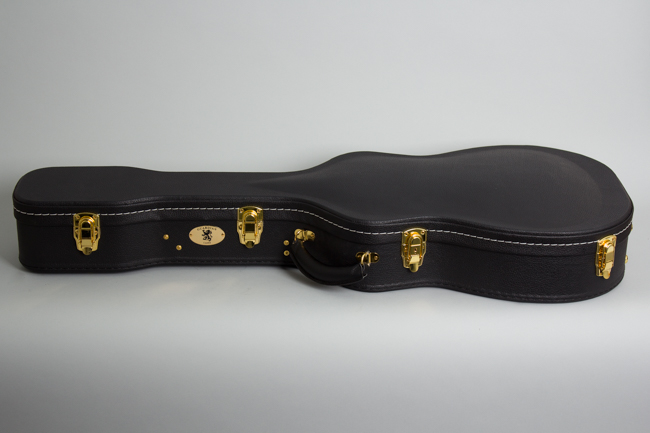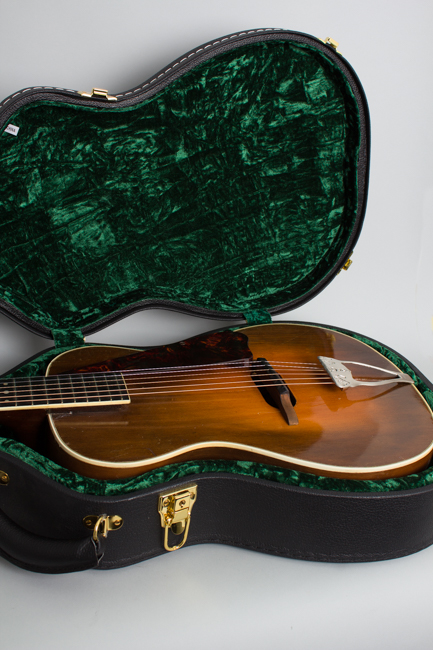Vivi-Tone Acousti-Guitar Acoustic Guitar , c. 1933
Vivi-Tone Acousti-Guitar Model Acoustic Guitar, c. 1933, made in Kalamazoo, Michigan, serial # 239, Cremona Brown Sunburst varnish finish, spruce top and back, maple sides, mahogany neck with ebony fingerboard, black hard shell case.
From the fertile imagination of renowned acoustic engineer Lloyd Loar came this truly unique acoustic guitar, one of the most distinctive fretted creations of the 1930's. Ten years on from his stint at Gibson, Loar and former Gibson associate Lewis Williams launched the Vivi-tone company to market their electric guitar concepts. Vivi-Tone was primarily concerned with the development of amplified instruments, but as sales were minimal they also marketed these "Acousti-Guitar" models for more conservative players (well…maybe!) which embody the unusual fruits some of Loar's acoustic theories.
This radical instrument almost turns the guitar inside out; the arched solid spruce BACK is the soundboard as much as the spruce top. The laminated rims are very heavy to prevent any vibration, and the back is recessed into them to avoid contact with the player. The only soundhole in the top is under the substantial maple and ebony bridge, while the back carries two small f-holes. The neck is nearly 2" wide with a substantial "V" shape, but is surprisingly comfortable with standard frets (some Vivi-Tones have unusually high fretwire). The long pickguard is very heavy tortoise celluloid.
This guitar is built of high grade materials to a very high standard, certainly in a class with Gibsons of the era. The subtle hand-rubbed sunburst on the top, back, and rims is similar to 1920's Loar-era "Cremona Brown" Gibson finishes. The top and back are triple-bound, the neck single-bound. The strikingly Art Nouveau "Vivi-Tone" logo is screened onto the ivory celluloid headstock veneer and cast into the tailpiece. The tuners are individual riveted Grovers with metal buttons. A label inside carries serial # 239 and reads "patent applied for". This particular guitar does not carry the second label found in many Vivi-Tones encouraging the purchaser to trade the instrument back (at "full value"!) within a year for an electric model.
Sadly the electric revolution came too late for Vivi-Tone, the company only lasting a short time but leaving behind some of the most unique guitars ever built, both acoustic and electric. This Acousti-Guitar is nicely original with only the tailpiece being a reproduction and in fine playing condition. The sound is surprisingly loud for so small a guitar (Loar wasn't COMPLETELY out of his tree) and carries extremely well, perhaps most reminiscent of a roundhole archtop like a Gibson L-4. Although a blind alley in guitar evolution, this Vivi-Tone Acousti-Guitar is still a fascinating creation and a truly unique musical personality.
Overall length is 39 1/2 in. (100.3 cm.), 13 1/4 in. (33.6 cm.) wide at lower bout, and 3 7/8 in. (9.8 cm.) in depth, measured at side of rim. Scale length is 24 1/4 in. (616 mm.). Width of nut is 1 7/8 in. (48 mm.).
This guitar shows general wear overall, but with no notable no damage or major repairs. The finish has scuffs, dings and scrapes but no large areas of wear except it is partially down to the wood on the back of the neck; someone actually did play this unusual guitar! All the hardware is original except the tailpiece is an exact repro cast from an original; it is nickel plated rather then the unplated look of the original but otherwise is a dead ringer for that oft-broken or missing original piece. The pickguard has a bit of upward warping but is still fully intact.
The original frets have been lightly polished out and -- believe it or not -- this is a very fine playing guitar with a lot more sound than one might expect. The neck has the fairly sharp "V" profile typical of the 1930s but is not overly thick, and not uncomfortable for its type. More than a historical oddity, this is one of the most interesting acoustic guitars of the 20th century, if far from the best remembered! Overall Excellent Condition.
From the fertile imagination of renowned acoustic engineer Lloyd Loar came this truly unique acoustic guitar, one of the most distinctive fretted creations of the 1930's. Ten years on from his stint at Gibson, Loar and former Gibson associate Lewis Williams launched the Vivi-tone company to market their electric guitar concepts. Vivi-Tone was primarily concerned with the development of amplified instruments, but as sales were minimal they also marketed these "Acousti-Guitar" models for more conservative players (well…maybe!) which embody the unusual fruits some of Loar's acoustic theories.
This radical instrument almost turns the guitar inside out; the arched solid spruce BACK is the soundboard as much as the spruce top. The laminated rims are very heavy to prevent any vibration, and the back is recessed into them to avoid contact with the player. The only soundhole in the top is under the substantial maple and ebony bridge, while the back carries two small f-holes. The neck is nearly 2" wide with a substantial "V" shape, but is surprisingly comfortable with standard frets (some Vivi-Tones have unusually high fretwire). The long pickguard is very heavy tortoise celluloid.
This guitar is built of high grade materials to a very high standard, certainly in a class with Gibsons of the era. The subtle hand-rubbed sunburst on the top, back, and rims is similar to 1920's Loar-era "Cremona Brown" Gibson finishes. The top and back are triple-bound, the neck single-bound. The strikingly Art Nouveau "Vivi-Tone" logo is screened onto the ivory celluloid headstock veneer and cast into the tailpiece. The tuners are individual riveted Grovers with metal buttons. A label inside carries serial # 239 and reads "patent applied for". This particular guitar does not carry the second label found in many Vivi-Tones encouraging the purchaser to trade the instrument back (at "full value"!) within a year for an electric model.
Sadly the electric revolution came too late for Vivi-Tone, the company only lasting a short time but leaving behind some of the most unique guitars ever built, both acoustic and electric. This Acousti-Guitar is nicely original with only the tailpiece being a reproduction and in fine playing condition. The sound is surprisingly loud for so small a guitar (Loar wasn't COMPLETELY out of his tree) and carries extremely well, perhaps most reminiscent of a roundhole archtop like a Gibson L-4. Although a blind alley in guitar evolution, this Vivi-Tone Acousti-Guitar is still a fascinating creation and a truly unique musical personality.
Overall length is 39 1/2 in. (100.3 cm.), 13 1/4 in. (33.6 cm.) wide at lower bout, and 3 7/8 in. (9.8 cm.) in depth, measured at side of rim. Scale length is 24 1/4 in. (616 mm.). Width of nut is 1 7/8 in. (48 mm.).
This guitar shows general wear overall, but with no notable no damage or major repairs. The finish has scuffs, dings and scrapes but no large areas of wear except it is partially down to the wood on the back of the neck; someone actually did play this unusual guitar! All the hardware is original except the tailpiece is an exact repro cast from an original; it is nickel plated rather then the unplated look of the original but otherwise is a dead ringer for that oft-broken or missing original piece. The pickguard has a bit of upward warping but is still fully intact.
The original frets have been lightly polished out and -- believe it or not -- this is a very fine playing guitar with a lot more sound than one might expect. The neck has the fairly sharp "V" profile typical of the 1930s but is not overly thick, and not uncomfortable for its type. More than a historical oddity, this is one of the most interesting acoustic guitars of the 20th century, if far from the best remembered! Overall Excellent Condition.
